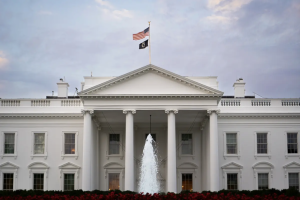‘Unprecedented’
 The White House in Washington
The White House in Washington As President Joe Biden on Monday touted his apparent deficit-cutting mettle, a nonpartisan fiscal policy research group warned of an “unprecedented” explosion in the federal budget deficit, which it said is on track to double to $2 trillion this year.
In a Labor Day speech in Philadelphia on Monday, President Biden touted his economic policies while taking a series of jabs at his predecessor, President Donald Trump.
“Unlike the last president, in my first two years … I cut the deficit $1.7 trillion,” President Biden boasted.
What President Biden failed to mention, however, is that most of the massive deficit drop in 2022 was a one-off, driven by what experts say was a one-time inflation-related explosion in tax revenue and capital gains.
And while the president touted his supposed deficit-slashing accolades, the Committee for a Responsible Federal Budget (CRFB), a nonpartisan organization that seeks to educate the public on issues with significant fiscal policy impact, projected that the deficit under the president’s watch would double in 2023 to around $2 trillion.
Deficit 122 Percent Higher so Far in 2023
After record government spending in 2020 and 2021 in part to offset the negative economic impact of the COVID-19 pandemic, the federal budget deficit dropped by a record amount in 2022 from near $3 trillion to around $1 trillion.
In February, the CBO projected that the budget deficit for 2023 would rise to around $1.4 trillion, while projecting that, in coming years, deficits would gradually rise each year, hitting $2.7 trillion in 2033.
But the CRFB’s latest estimate shows that the pace of deficit spending under President Biden’s watch is rising faster than CBO’s February projections and will hit $2 trillion this year.
He added that what’s driving the CRFB’s projections for a doubling of the budget deficit is a combination of a rise in spending due to soaring interest rates, higher Social Security and Medicare costs, a lack of Federal Reserve remittances to the U.S. Treasury, and a “big” budget deal.
“It is disappointing that the President continues to propose trillions of dollars in new spending and tax breaks without a plan to put our debt on a sustainable path,” the organization added.
“Compared to the national deficit of $726 billion for the same period last year (Oct 2021—Jul 2022), our national deficit has increased by $887 billion,” Treasury said in a statement, noting that the deficit was 122 percent higher so far this year compared to the same period last year.
Deficit ‘Doom Loop’?
As the U.S. central bank has raised its benchmark Fed Funds rate rapidly in a feverish bid to quash soaring inflation, interest payments on government debt have climbed, prompting warnings from prominent economists.
Mr. Summers said that the Biden administration’s big spending initiatives, including the student loan forgiveness that caused the monthly deficit to jump 562 percent, could shake investor confidence.
“If your deficit projection starts to get out of control and your real interest rates start to rise rapidly, you can get into a kind of doom loop,” Mr. Summers told the outlet. “We’re going to need to be watching our own fiscal projections in the United States very carefully.”
Comparing the first 10 months of fiscal year 2022 to fiscal year 2023 (the Treasury Department’s fiscal years run from Oct. 1 of a given year to Sept. 30 of the following), net interest on public debt is 34 percent higher this year.
The government’s interest rate payments, which are ultimately paid for by taxpayers, were $572 billion so far in fiscal year 2023 compared to $426 billion in the comparable period in fiscal year 2022.
The reason for the jump is because interest rates on all the various forms of U.S. government debt were significantly higher this fiscal year than last year as the Fed has hiked rates aggressively to dampen inflation.
In the face of risks to the nation’s fiscal health, Republicans have taken opportunities—like during recent talks on lifting the debt ceiling cap—to push for spending cuts.










